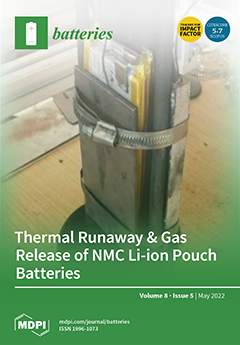Unravelling the lithium-ion transport mechanism in α-Fe
2O
3 nanofibers through in situ electrochemical impedance studies is crucial for realizing their application in high-performance anodes in lithium-ion batteries. Herein, we report the effect of heat treatment conditions on the structure, composition, morphology,
[...] Read more.
Unravelling the lithium-ion transport mechanism in α-Fe
2O
3 nanofibers through in situ electrochemical impedance studies is crucial for realizing their application in high-performance anodes in lithium-ion batteries. Herein, we report the effect of heat treatment conditions on the structure, composition, morphology, and electrochemical properties of α-Fe
2O
3 nanofibers as an anode for lithium-ion batteries. The α-Fe
2O
3 nanofibers were synthesized via electrospinning and post-annealing with differences in their annealing temperature of 300, 500, and 700 °C to produce FO300, FO500, and FO700 nanofibers, respectively. Improved electrochemical performance with a high reversible specific capacity of 599.6 mAh g
−1 at a current density of 1 A g
−1 was achieved after 50 cycles for FO700. The in situ electrochemical impedance spectroscopy studies conducted during the charge/discharge process revealed that the charge transfer and Li-ion diffusion behaviors were related to the crystallinity and structure of the as-synthesized α-Fe
2O
3 nanofibers. The surfaces of the α-Fe
2O
3 nanofibers were converted into Fe metal during the charging/discharging process, which resulted in improved electrical conductivity. The electron lifetime, as determined by the time constant of charge transfer, revealed that, when a conversion reaction occurred, the electrons tended to travel through the iron metal in the α-Fe
2O
3 nanofibers. The role of iron as a pseudo-resistor with negligible capacitance was revealed by charge transfer resistance analysis.
Full article





